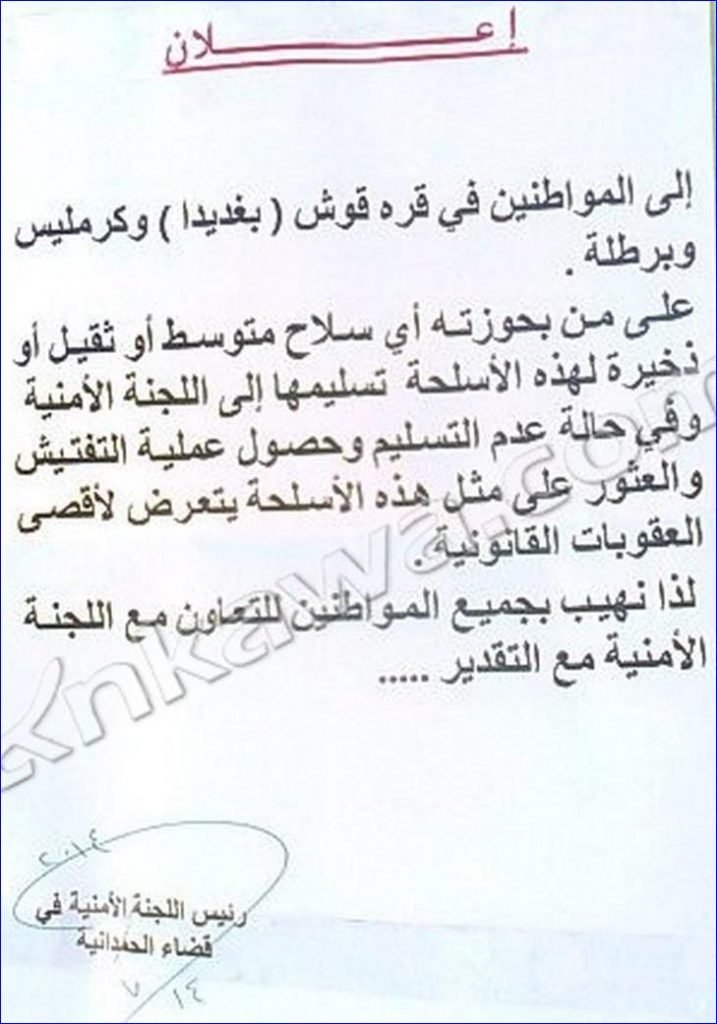In July 2014, as Daesh began its incursion into Iraqi territory, the Kurdistan Democratic Party (KDP) began its systematic disarmament of Assyrians and several other ethnic groups so that it could use their weapons in its own struggle.

A disarmament order that was circulated by the KRG in Assyrian towns on the Nineveh plains. (Courtesy of ankawa.com)
Notices were circulated threatening severe punishment for noncompliance. Assurances were given that the Peshmerga would provide some degree of protection.
But as Daesh advanced, the (Kurdish) Peshmerga took the weapons and fled, following the same example as the Iraqi Army.
This left the Assyrians and Yazidis with no means to resist or defend themselves against Daesh. Reports even surfaced of these same Peshmerga gunning down Yazidis who tried to prevent them from fleeing with all the weapons. Haydar Shesho, a Yazidi commander who managed to procure weapons from the Iraqi government, was then arrested by KDP authorities for organizing an “illegal” militia.
This scene was repeated elsewhere throughout the country, as 150,000 Assyrians were forced to flee the Nineveh plains, their ancestral land. These actions can only be seen as a deliberate ploy by the Kurdish leadership to allow foreign forces to violently cleanse these areas of all non-Kurdish residents and then, with the help of their U.S. allies, retake and “liberate their lands.”
Watch: Assyrians demanding an end to the Kurdish occupation of their land:
On April 13, 2016, Kurdish security forces blocked hundreds of Assyrians from participating in a protest outside of the Kurdistan Regional Government Parliament building. The protest was planned in response to the ongoing confiscation of Assyrian land by Kurds in northern Iraq.
Many testimonies have surfaced, such as a statement given to the UK Parliament by Yazidi ex-captive Salwa Khalaf Rasho, in which it is said that the Peshmerga, eager to flee first ahead of Yazidi civilians, has refused requests to stay and protect Yazidis or at least leave them their weapons. They had even reassured the Yazidis that they should return to their homes, where they would be defended.
Some Peshmerga ultimately started firing on Yazidis when their protests grew forceful – killing some of them – in order to clear the way for their convoy of vehicles to pass unhindered. Yazda, an organization that campaigns for Yazidi genocide recognition, wrote in its last report in January 2016: “Had they [Yazidis] been defended for one day, they could have been evacuated safely and the massacres and enslavement crisis could have been averted.”
The following is an excerpt from Rasho’s testimony to the UK Parliament in which she pleaded for help after escaping eight months of Daesh slavery, rape and multiple attempted suicides.
“My name is Salwa Khalaf Rasho. I was born in 1998 and was in the ninth grade. I was leading a simple and modest life with my family until the day when Daesh attacked Shengal on August 3, 2014. I liked my city, Shengal, very much. I grew up under the principle of coexistence with all societies within the community, regardless of one’s religion or sect, because the values of my religion do not allow to hate others and discriminate against them.
Therefore, Shengal was well known as the city of tolerance and ethnic diversity. What happened was shocking and unexpected, because we saw Daesh as our brothers. With this, I mean the Arab tribes of the villages that belong to Shengal. Suddenly, they became monsters and wolves. They collaborated with Daesh when Yazidi women and children were enslaved and men were killed.There were about 9,000 Peshmerga in my city who were armed with various types of weapons. They said to us, ‘We will protect and defend Shengal, and Daesh will only enter Shengal over our dead bodies. We will defend Shengal until the last bullet.’”Unfortunately, they ran away without any resistance and without warning or giving notice to the civilians so we could escape from falling into the arms of Daesh monsters. They left us women and children to our cold-blooded fate. I and the people with me tried to flee into the mountains like the others.”
Watch: How Kurds disarmed Assyrian Christians and abandoned them to Daesh:
Amnesty International Accuses YPG of Human Rights Abuses
Amnesty International’s many refutable allegations against the Syrian government and the Syrian Arab Army cannot be taken at face value in the absence of other corroborating reports. In some cases, however, they do report truthfully, such as when they released a report in 2015 accusing the YPG, the militia of Syria’s Kurdish population, of a range of human rights abuses.“
These abuses include forced displacement, demolition of homes, and the seizure and destruction of property,” the group wrote. “In some cases, entire villages have been demolished, apparently in retaliation for the perceived support of their Arab or Turkmen residents for the group that calls itself the Islamic State (IS) or other non-state armed groups.” Amnesty International has also documented the use of child soldiers, according to Lama Fakih, a senior crisis advisor for the group.
The Kurds claim that their “Kurdistan” is “multicultural and multireligious,” which is disingenuous when you consider that those additional cultures consist of people now dwelling amongst a Kurdish majority in lands the Kurds took by force. These people will be faced with the prospect of casting meaningless votes on Kurdish independence since, even if they all voted “no,” they would nonetheless be outvoted by the Kurdish “yes” majority and as a result would still find themselves subject to a Kurdish government and agenda.


Does “moderation” mean CENSORSHIP ?
LikeLike
This 100 year old “MIDDLE-EAST Crisis” is the result of GREED DRAWING BORDERS. Picot-Sykes ! Shoulda went with the RUSSIAN/ITAL
IAN Plan whose borders would have taken into consideration ETHNIC & CULTURAL HISTORY.
LikeLike